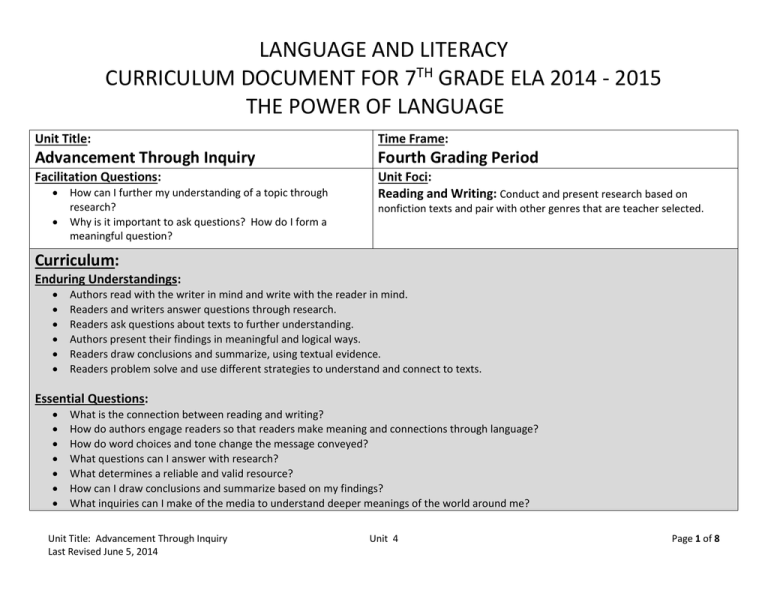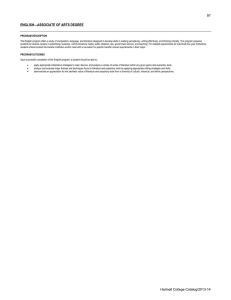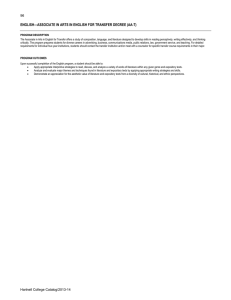LANGUAGE AND LITERACY CURRICULUM DOCUMENT FOR 7 GRADE ELA 2014 - 2015
advertisement

LANGUAGE AND LITERACY CURRICULUM DOCUMENT FOR 7TH GRADE ELA 2014 - 2015 THE POWER OF LANGUAGE Unit Title: Time Frame: Advancement Through Inquiry Fourth Grading Period Facilitation Questions: Unit Foci: Reading and Writing: Conduct and present research based on How can I further my understanding of a topic through research? Why is it important to ask questions? How do I form a meaningful question? nonfiction texts and pair with other genres that are teacher selected. Curriculum: Enduring Understandings: Authors read with the writer in mind and write with the reader in mind. Readers and writers answer questions through research. Readers ask questions about texts to further understanding. Authors present their findings in meaningful and logical ways. Readers draw conclusions and summarize, using textual evidence. Readers problem solve and use different strategies to understand and connect to texts. Essential Questions: What is the connection between reading and writing? How do authors engage readers so that readers make meaning and connections through language? How do word choices and tone change the message conveyed? What questions can I answer with research? What determines a reliable and valid resource? How can I draw conclusions and summarize based on my findings? What inquiries can I make of the media to understand deeper meanings of the world around me? Unit Title: Advancement Through Inquiry Last Revised June 5, 2014 Unit 4 Page 1 of 8 Spiraling TEKS: Fig. 19 Reading/Comprehension Skills. Students use a flexible range of metacognitive reading skills in both assigned and independent reading to understand an author’s message. Students will continue to apply earlier standards with greater depth in increasingly more complex texts as they become self-directed, critical readers. The student is expected to: Fig. 19 (A) establish purposes for reading selected texts based upon own or others’ desired outcome to enhance comprehension Fig. 19 (B) ask literal, interpretive, evaluative, and universal questions of text Fig. 19 (C) reflect on understanding to monitor comprehension (e.g., summarizing and synthesizing; making textual, personal, and world connections; creating sensory images) Fig. 19 (D) make complex inferences about text and use textual evidence to support understanding RS, SS Fig. 19 (E) summarize, paraphrase, and synthesize texts in ways that maintain meaning and logical order within a text and across texts RS, SS Fig. 19 (F) make connections between and across texts, including other media (e.g., film, play), and provide textual evidence RS 7.1 (A) adjust fluency when reading aloud grade-level text based on the reading purpose and the nature of the text 7.2 (A) determine the meaning of grade-level academic English words derived from Latin, Greek, or other linguistic roots and affixes RS 7.2 (B) use context (within a sentence and in larger sections of text) to determine or clarify the meaning of unfamiliar or ambiguous words RS 7.2 (C) complete analogies that describe part to whole or whole to part 7.2 (D) identify the meaning of foreign words commonly used in written English with emphasis on Latin and Greek words (e.g., habeus corpus, e pluribus unum, bona fide, nemesis) 7.2 (E) use a dictionary, a glossary, or a thesaurus (printed or electronic) to determine the meanings, syllabication, pronunciations, alternate word choices, and parts of speech of words RS 7.14 (A) plan a first draft by selecting a genre appropriate for conveying the intended meaning to an audience, determining appropriate topics through a range of strategies (e.g., discussion, background reading, personal interests, interviews), and developing a thesis or controlling idea 7.14 (B) develop drafts by choosing an appropriate organizational strategy (e.g., sequence of events, cause-effect, compare-contrast) and building on ideas to create a focused, organized, and coherent piece of writing RS 7.14 (C) revise drafts to clarify meaning, enhance style, include simple and compound sentences, and improve transitions by adding, deleting, combining, and rearranging sentences or larger units of text after rethinking how well questions of purpose, audience, and genre have been addressed RS 7.14 (D) credit drafts for grammar, mechanics, and spelling RS 7.14 (E) revise final draft in response to feedback from peers and teacher and publish written work for appropriate audiences 7.17 (C) write responses to literary or expository texts that demonstrate the writing skills for multi-paragraph essays and provide sustained evidence from the text using quotations when appropriate 7.19 (A) identify, use and understand the function of the parts of speech in the context of reading, writing, and speaking RS, SS Unit Title: Advancement Through Inquiry Last Revised June 5, 2014 Unit 4 Page 2 of 8 (i) verbs (perfect and progressive tenses) and participles (ii) appositive phrases (iii) adverbial and adjectival phrases and clauses (iv) conjunctive adverbs (e.g., consequently, furthermore, indeed) (v) prepositions and prepositional phrases and their influence on subject-verb agreement (vi) relative pronouns (e.g., whose, that, which) (vii) subordinating conjunctions (e.g., because, since) (viii) transitions for sentence to sentence or paragraph to paragraph coherence 7.19 (B) differentiate between the active and passive voice and know how to use them both SS 7.19 (C) use complete simple and compound sentences with correct subject-verb agreement RS 7.21 (A) spell correctly, including using various resources to determine and check correct spellings RS The student will know and be able to: Fig. 19 (D), (E), (F) (see spiraling) 7.9 (A) explain the difference between the theme of a literary work and the author’s purpose in an expository text SS 7.10 (A) evaluate a summary of the original text for accuracy of the main ideas, supporting details, and overall meaning RS 7.10 (B) distinguish factual claims from commonplace assertions and opinions SS 7.10 (C) use different organizational patterns as guides for summarizing and forming an overview of different kinds of expository text RS 7.10 (D) synthesize and make logical connections between ideas within a text and across two or three texts representing similar or different genres, and support those findings with textual evidence RS 7.11 (A) analyze the structure of the central argument in contemporary policy speeches (e.g., argument by cause and effect, analogy, authority) and identify the different types of evidence used to support the argument SS 7.12 (B) identify such rhetorical fallacies as ad hominem, exaggeration, stereotyping, or categorical claims in persuasive texts SS 7.13 (A) interpret both explicit and implicit messages in various forms of media SS 7.13 (B) interpret how visual and sound techniques (e.g., special effects, camera angles, lighting, music) influence the message 7.13 (D) assess the correct level of formality and tone for successful participation in various digital media 7.17 (D) expected to: produce a multimedia presentation involving text and graphics using available technology 7.18 (A) establishes a clear thesis or position SS 7.18 (B) considers and responds to the views of others and anticipates and answers reader concerns and counter-arguments 7.18 (C) includes evidence that is logically organized to support the author’s viewpoint and that differentiates between fact and opinion SS 7.22 (A) brainstorm, consult with others, decided upon a topic, and formulate a major research question to address the major research topic 7.22 (B) apply steps for obtaining and evaluating information from a wide variety of sources and create a written plan after preliminary research in reference works and additional text searches 7.23 (A) follow the research plan to gather information from a range of relevant print and electronic sources using advanced search strategies Unit Title: Advancement Through Inquiry Last Revised June 5, 2014 Unit 4 Page 3 of 8 7.23 (B) categorize information thematically in order to see the larger constructs inherent in the information. 7.23 (C) record bibliographic information (e.g., author, title, page number) for all notes and sources according to a standard format 7.23 (D) differentiate between paraphrasing and plagiarism and identify the importance of citing valid and reliable sources 7.24 (A) narrow or broaden the major research question, if necessary, based on further research and investigation 7.24 (B) utilize elements that demonstrate the reliability and validity of the sources used (e.g., publication date, coverage, language, point of view) and explain why one source is more useful than another 7.25 (A) draws conclusions and summarizes or paraphrases the findings in a systematic way 7.25 (B) marshals evidence to explain the topic and gives relevant reasons for conclusions 7.25 (C) presents the findings in a meaningful format 7.25 (D) follows accepted formats for integrating quotations and citations into the written text to maintain a flow of ideas 7.26 (A) listen to and interpret speaker’s purpose by explaining the content, evaluating the delivery of the presentation and asking questions or making comments about the evidence that supports a speaker’s claims 7.26 (B) follow and give complex oral instructions to preform specific tasks, answer questions, or solve problems 7.26 (C) draw conclusions about the speaker’s message by considering verbal communication (e.g., word choice, tone and nonverbal cues e.g., posture, gestures, facial expressions) 7.27 (A) present a critique of a literary work, film, or dramatic production, employing eye contact, speaking rate, volume, enunciation, a variety of natural gestures, and conventions of language to communicate ideas effectively 7.28 (A) participate productively in discussions, plan agendas with clear goals and deadlines, set time limits for speakers, take notes, and vote on key issues Student Understanding (student friendly TEKS): Fig. 19 (D) I will infer using textual evidence. Fig. 19 (E) I will summarize and put text into my own words in ways that keep the same order so that the meaning is not changed. Fig.19 (F) I will make connections to other texts while I am reading. I will say to myself This reminds me of… 7.9 (A) I will describe the difference between the theme in a story and the purpose of an expository text. SS 7.10 (A) I will evaluate the summary of an informational text to see if the main idea and important details are included. RS 7.10 (B) I will distinguish between facts and commonplace assertions and opinions. SS 7.10 (C) I will use the different organizational patters in expository texts as a guide for summarizing. RS 7.10 (D) I will read expository text and (1) synthesize ideas within the text, (2) make logical connections between it and other texts, and (3) provide textual evidence to support my thinking. RS 7.11 (A) I will describe how the central arguments in current speeches are built and name the types of evidence used to support the argument. SS 7.12 (B) I will explain how the graphical components help to create meaning in an informational text. SS 7.13 (A) I will interpret the explicit and implicit messages in different forms of media. SS 7.13 (B) I will explain how the special effects, camera angles, lighting, and music affect the message that the audience hears and/or sees. Unit Title: Advancement Through Inquiry Last Revised June 5, 2014 Unit 4 Page 4 of 8 7.13 (D) I will decide how formal participants need to be and what tone participants need to use in different digital media. 7.17 (D) I will make a multimedia presentation using text and graphics. 7.18 (A) I will write an essay to persuade and establish a clear position. 7.18 (B) I will write a persuasive essay that looks at what other people say on the same topic, and I will anticipate concerns and respond to them, including arguments for a different viewpoint. 7.18 (C) I will write a persuasive essay that includes evidence that is organized in a way that makes sense and will include only facts, not opinions because I will know the difference. 7.22 (A) I will brainstorm with others about different topics until we find a question that we can research. 7.22 (B) I will use my research plan to get and evaluate information from a variety of sources. 7.23 (A) I will find information from different sources and decide which information is relevant from a source I can trust. 7.23 (B) I will put the information in an order to see the connections between ideas. 7.23 (C) I will make a list of all the sources that I used for information. I will include author, title and page number for each piece of information. 7.23 (D) I will know the difference between paraphrasing and plagiarism and be able to cite valid sources correctly. 7.24 (A) I will narrow or broaden the major research question, if necessary, based on further research and investigation. 7.24 (B) I will evaluate the reliability of the sources I used and explain which ones are better. 7.25 (A) I will present my research project that summarizes my findings in a systematic way, interpret the information that I find and organize it by both summarizing and paraphrasing the information. 7.25 (B) I will present my research project to explain my topic and use relevant reasons for my interpretations. 7.25 (C) I will present my research to an audience using a meaningful format. 7.25 (D) I will present my research project and use quotations and citations correctly to maintain the flow of ideas. 7.26 (A) I will listen and interpret what a speaker says by asking appropriate questions and commenting on supporting evidence. 7.26 (B) I will follow and give complex oral instructions to preform specific tasks, answer questions, or solve problems. 7.26 (C) I will watch the speaker's posture and gestures and listen carefully to the way the speaker talks so that I get more information about the speaker's message. 7.27 (A) I will use everything I know about public speaking to present a review of a film, book, or play. 7.28 (A) I will participate appropriately with other team members to discuss, plan agendas, set time limits, take notes, and vote on key issues. Targeted College Readiness Standards: Click here to access CCRS document in full. Targeted ELPs: Click here to access ELPS TEA web document in full. Language of Instruction: revise edit Unit Title: Advancement Through Inquiry Last Revised June 5, 2014 Academic Vocabulary (for mastery by the end of the year): Review all terms Unit 4 Page 5 of 8 Cornell Notes MLA citation Cite Source Plagiarism Paraphrase Research plan Implicit and explicit messages Valid Categorize Research question Topic Ad hominem Categorical claim Assertion Fallacy Stereotype Instruction: These materials and instructional experiences offer workable components which necessitate the addition of other choices to construct a sequence of learning experiences in which reading and writing blend. Reading Skill Focus: Written Composition and Grammar: Reading: Composition/Essay: make inferences and draw conclusions based on text based evidence make connections between and across texts from the same and different genres evaluate ways media (including speeches) delivers messages and influences audience distinguish between facts and commonplace assertions and opinions evaluate summaries of informational texts identify and synthesize organizational pattern of text synthesize and logically organize collected information Unit Title: Advancement Through Inquiry Last Revised June 5, 2014 Unit 4 Instructional focus o Follow Denton ISD Research Plan for Middle School (in Research Folder on “O:Drive” Cornell Notes http://www.google.com/search?q=cornell+notes&sourcei d=ie7&rls=com.microsoft:en-us:IE-SearchBox&ie=&oe= Questions - create meaningful questions Note-taking – plagiarism vs. paraphrasing Summary – synthesizing and thinking o develop a research question o works cited (MLA) o identify reliable resources Page 6 of 8 Cornell Notes http://www.google.com/search?q=cornell+notes&sourceid= ie7&rls=com.microsoft:en-us:IE-SearchBox&ie=&oe= o Questions - create meaningful questions o Note-taking – name source (title and author); plagiarism vs. paraphrasing o Summary – synthesizing and thinking o primary vs. secondary sources o quoting from a mentor text Composition focus o Research paper or multi-media project Grammar and conventions: semicolons; colons: hyphens application of all previously learned skills Core Text Experiences – Teachers choose a representative selection of informational texts along with complementary texts that reflect the Enduring Understandings of advancement through inquiry. Suggested texts (excerpts or full text): Reflective Essay – I am a Native of North America, pp. 444-448 Instructional Manual & Government Publication & Signs – How to Recognize Venomous Snakes in North America, How to Avoid Venomous Snake Bites, and Park Warning Signs, pp. 531-534 Speech – “Summary of the Gettysburg Address”, p.156 Novel – Carolyn Meyer, White Lilacs Novel—Christopher Paul Curtis, The Watsons Go to Birmingham Novel—Mildred Taylor, Roll of Thunder, Hear My Cry Resources: Prentice Hall Language and Literacy unit resources for instruction and assessment ideas Prentice Hall Writing Coach unit resources Technology: As teachers use this document, we will add here their Career Connections/Real Life Application: As teachers use this ideas about ways to use technology in this unit. document, we will add here their ideas about ways to make career and real life applications in this unit. TA: 7.3.A – create a research plan to guide inquiry; TA: 7.3.B – use and evaluate various search strategies, including keyword(s) and Boolean operators; TA: 7.3.C – select and evaluate various types of digital resources for accuracy and validity; TA: 7.3.D – process data and communicate results; TA: 7.5.A – understand and practice copyright principles, including current laws, fair use guidelines, creative commons, Unit Title: Advancement Through Inquiry Last Revised June 5, 2014 Unit 4 Page 7 of 8 open source, and public domain; TA: 7.5.B – practice ethical acquisition of information and standard methods for citing sources; Exemplar Lessons: As teachers use this document, we will add Research Based Instructional Strategies: As teachers use this exemplar lessons here document, we will add representative research-based instructional strategies here. Assessment: Modify or supplement the suggested assessments below to complement unit activities and ensure varied assessments throughout the year. Student self-assessment & reflection: Acceptable evidence or artifacts: Cornell Notes Research project (e.g. trading cards, essay, brochure, etc.) Unit Title: Advancement Through Inquiry Last Revised June 5, 2014 Unit 4 Page 8 of 8



